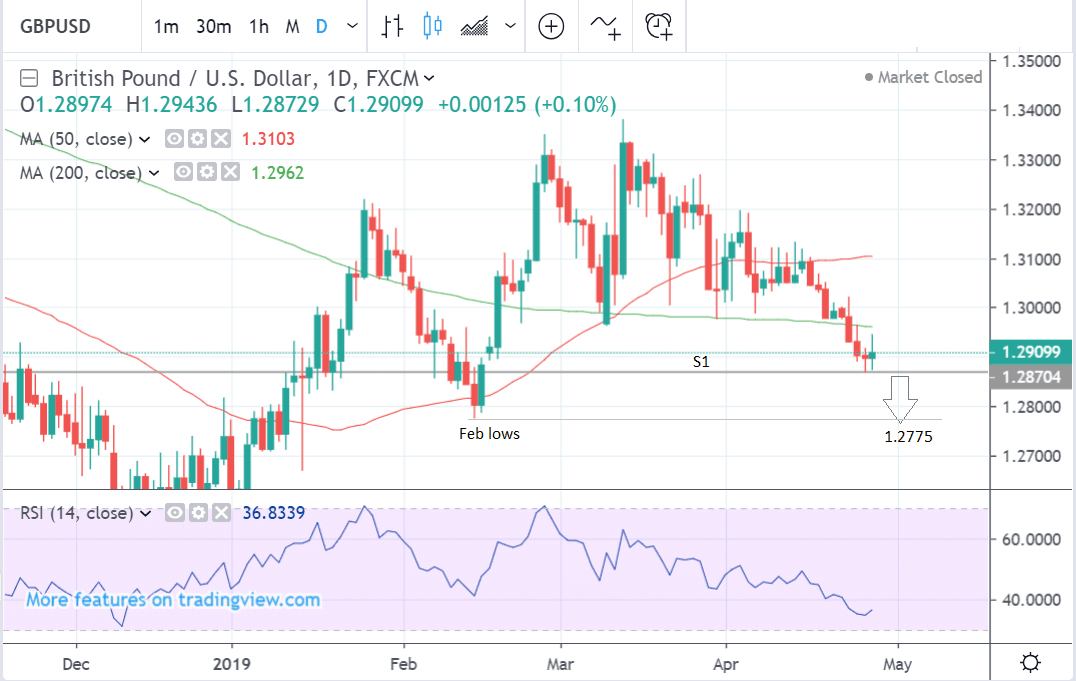Pound-to-Dollar Exchange Rate 5-Day Forecast: Short-term Bear Trend to Extend

Image © Adobe Images
- Break below 1.30 and 200-day sure bearish signs
- More downside probable conditional on confirmation
- Pound to take cue from BOE assessment; Dollar from Fed
The Pound / U.S. Dollar rate starts the new week at 1.2910, about a half a percent lower than where it was a week ago and nearly a percent below where it was trading one month ago.
The pair lost ground as the outlook for the U.S. economy steadily improved, with blow-out GDP numbers out last Friday confirming the trend, whilst a continued impasse in Brexit negotiations between the U.K’s two major political parties meant Sterling flatlined.
From a technical perspective, the break below both the 1.3000 level and the 200-day MA has biased the trend to a more bearish outlook. It is now possible the pair will extend its decline to the next set of targets at the 1.27 February lows.
GBP/USD has looked weak ever since breaking below the 1.3000 rubicon. So far it has fulfilled its bearish promise. Now, the exchange rate has also broken convincingly below the 200-day moving average (MA) suggesting even more weakness on the horizon.
The next major support level is the February low at 1.2775. In between, there is little in the way of support or resistance to impede further downside.
On Thursday the market touched down on the S1 monthly pivot at 1.2868, formed a doji candlestick and started reversing higher. Pivots, as the name suggests, are levels where reversals often happen. They were once used by pit traders as rough and ready guide to overbought or - as in this case - oversold levels.
The recovery at the end of last week, however, is unlikely to progress and will probably ultimately be capped by the 200-day at 1.2962 at which level it will probably stall and reverse. From there it should start the next leg lower towards the 1.27s.
Time to move your money? Get 3-5% more currency than your bank would offer by using the services of foreign exchange specialists at RationalFX. A specialist broker can deliver you an exchange rate closer to the real market rate, thereby saving you substantial quantities of currency. Find out more here.
* Advertisement
The Dollar: What to Watch this Week

It is a busy week for the Dollar with much data scheduled that could be market moving. The daddy of them all, however, is likely to be the Federal Reserve (Fed) meeting on Wednesday at 19.00 BST. Here the big question will be whether the Fed will still retains its ‘cautious’ tone or opts to be more optimistic after the huge GDP beat in Q1.
Analysts at Wells Fargo argue Q1 GDP data was not as good as it looked and that the Fed will, therefore, probably remain in ‘cautious’ mode.
Their argument is that GDP data seemed higher because of inventory build-ups whilst the real motor of growth, consumerism, remained relatively subdued.
“Although the economy may not have been as strong in Q1 as the headline GDP growth rate suggests, the economy is not in danger of stalling anytime soon. That said, this week’s data support our expectation for the Fed to refrain from raising rates for the foreseeable future,” says Wells Fargo.
The other main releases on the calendar are inflation data, in the form of the Personal Consumption Expenditure report (PCE) on Monday, the Non-Farm Payrolls job report on Friday; and in between, and the ISM Manufacturing report on Wednesday.
Non-Farm Payrolls in April are forecast to show a 181k rise from 196k in March when released on Friday at 13.30. This would be in keeping with about the long-term average and probably not impact the Dollar overly.
Average earnings are more likely to impact the currency if they show a big move up or down, however, economists have forecast little change, up a basis point to 3.3% year-on-year and two basis points to 0.3% month-on-month, in April.
The core PCE price index (the Fed’s preferred inflation measure) will likely underscore the muted inflation picture as it’s expected to have moderated slightly from 1.8% year-on-year in February to 1.7% in March. Personal income and spending figures are also out on Monday. Both are forecast to have accelerated in March. The data is scheduled for release at 13.30.
The ISM manufacturing PMI for April will be closely watched on Wednesday at 15.00 when it is expected to show a decline to 55.0 from 55.3 previously. This follows an unexpected rebound in March.
The Pound: What to Watch This Week

The main event for the Pound is the Bank of England (BOE) rate meeting which will end with an announcement on Thursday at 12.00 BST.
The BOE is not expected to raise interest rates at the meeting despite robust economic data. Actual growth remains subdued at 1.2% (the weakest since 2009) due to business uncertainty going "through the roof" because of Brexit, so it is unlikely the Bank will want to change rates until after more clarity emerges.
Despite talk of a ‘grab and go’ rate hike in August, Reuters polls forecast rates will not move until early 2020, a calendar quarter later than was forecast a month ago.
The hunt for a new governor to replace Carney in October adds more uncertainty to the mix.
The BOE will publish its quarterly inflation report at the May meeting which includes the latest economic projections, and this is likely to garner more attention than usual - and possibly produce more volatility.
The pound is unlikely to see a big reaction to the BOE decision but any dovish tilt by the Bank - dovish meaning in favour of lower interest rates - could weigh on Sterling, which slipped to 10-week lows versus the US dollar this week.
Lower interest rates or the threat of them can be negative for a currency because they detract from foreign investment inflows, which tend to favour jurisdictions which can offer higher interest returns.
PMI Data
The other major release in the coming week are the release of PMIs for April. These may be closely watched as they recently declined in contraction territory which is defined as a reading below 50. They are seen as a forward indicator for the economy so this raised concerns softer official economic data is coming.
Although official UK data has not yet followed in their footsteps, another gloomy set of PMIs could increase the risk it will.
The Manufacturing PMI is out on Wednesday at 09:30 B.S.T.
In March the PMI rose because of stockpiling by companies preparing for a potentially distruptive Brexit, rather than due to genuine growth. The number expected by markets is 53.2, down from the previous month's 55.1.
Construction PMI fell to 49.7 in March and is forecast to rebound to 50.4 in April when data is released at 9.30 on Thursday.
UK services PMI is the big number to watch as this is a sector that accounts for over 80% of UK economic activity.
The previous month saw the Service PMI plunge below 50 and into contractionary territory in March, falling to 48.9, but data out on Friday at 9.30 is expected to show a rebound to 50.4 in April. If it disappoints the Pound could suffer.
Brexit Impasse Continues
Brexit could also still be a driver of the Pound in the week ahead. Talks between the government and the opposition Labour party have not reportedly made much progress. At the same time pressure is building on the Prime Minister, Theresa May, to resign. If she does go, the Pound will weaken.
On the other hand, the announcement of a joint deal with Labour could lead the way to a stronger Pound. Yet this seems unlikely given the UK’s adversarial political system which does not favour bi-partisanship.
There seems little incentive for Labour to help the Conservatives out of their current self-destructive, death-spin over Europe. If anything there is probably more chance of greater uncertainty in the short-term, not less, as Corbyn is more likely to bide his time and watch the Conservatives be their worst enemy than help Theresa May out of her current deadlock.
Time to move your money? Get 3-5% more currency than your bank would offer by using the services of foreign exchange specialists at RationalFX. A specialist broker can deliver you an exchange rate closer to the real market rate, thereby saving you substantial quantities of currency. Find out more here.
* Advertisement





